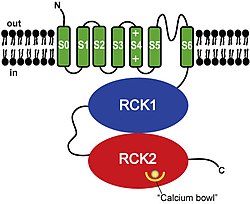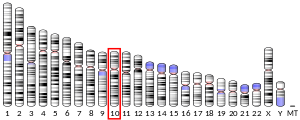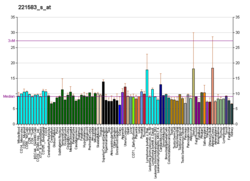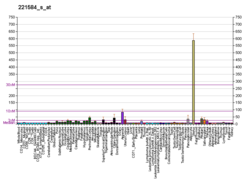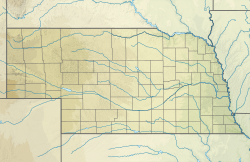칼슘 활성 칼륨 채널 서브유닛 알파-1
Calcium-activated potassium channel subunit alpha-1칼슘 활성 칼륨 채널 서브유닛 알파-1은 칼슘 활성 칼륨 채널, 서브 패밀리 M, 알파 멤버 1(K1Ca.1) 또는 BK 채널 알파 서브유닛으로도 알려져 있으며 [5]KCNMA1 유전자에 의해 인코딩된 전압 게이트 칼륨 채널로 세포막을 통해 칼륨 이온(K+)의 전도율이 큰 것이 특징이다.[6]
함수
BK 채널은 막 전기 전위의 변화 및/또는 세포내 칼슘 이온(Ca2+)의 농도 증가에 의해 활성화(개방)된다.[7][8]BK 채널을 개방하면 K는+ 수동적으로 채널을 통해 전기화학 구배 아래로 흐를 수 있다.전형적인 생리학적 조건 하에서, 이것은 세포로부터 K의+ 유출을 초래하여 세포막 초극화(세포막 전체에 걸친 전기 전위의 감소)와 세포의 흥분성 감소(세포가 작용 전위를 전달할 확률의 감소)로 이어진다.
BK 채널은 부드러운 근육톤과 신경의 흥분성을 포함한 몇 가지 주요 생리학적 과정을 조절하는데 필수적이다.[6]그들은 매끄러운 근육의 수축을 조절하고 골레아에서 머리카락 세포의 전기적 튜닝에 관여한다.또한 BK 채널은 고농도(> 100 mM 또는 약 0.50 % BAC)의 벌레 C.선충에서 에탄올의 행동 영향에 기여한다.[9]BK 채널이 인간의 도취에 기여하는지는 아직 결정되지 않았다.
구조
BK 채널은 내측 구조를 가지고 있다.채널 형성 알파 서브유닛의 각 모노머는 KCNMA1 유전자의 산물이다.변조 베타 하위 유니트(KCNMB1, KCNMB2, KCNMB3 또는 KCNMB4로 인코딩)는 사선 채널과 연결할 수 있다.대안으로 서로 다른 ISO 양식을 인코딩하는 분할된 대본 변형이 식별되었다.[6]
각 BK 채널 알파 서브유닛은 (N-에서 C-단자까지)로 구성된다.
- 모든 전압 의존 K+ 채널에 보존된 6개의 전송 영역(S1-S6) 앞에 있는 고유한 전송 영역(S0)[10]
- 전압 감지 도메인(S1-S4)
- K+ 채널 모공 도메인(S5, 선택성 필터 및 S6)
- 세포질 C-단자 영역(CTD)은 한 쌍의 RCK 도메인으로 구성되며, 4차 채널의 세포 내측에서 옥타미 게이팅 링으로 조립된다.[8][11][12][13][14][15][16]CTD에는 각 모노머의 두 번째 RCK 영역 내에 인코딩된 "칼슘 용기"라고 불리는 Ca에2+ 대한 4개의 1차 결합 사이트가 포함되어 있다.[8][11][15][16]
이용 가능한 X선 구조물은 다음과 같다.
- 3U6N – BK 채널 탕구 링의[16] 개방 구조
- 3MT5 – 인간 BK 탕구 장치의[8] 결정 구조
- 3NAF – 인간 고전도 케이 게이트2+ K+ 채널(BK 채널)[11]의 세포내 게이트 링 구조
약리학
BK 채널은 뇌졸중 치료에 대한 약리학적 표적이다.여러 제약회사들이 신경세포의 과도한 신경독성 칼슘 유입을 막기 위해 이들 채널을[17] 활성화하는 합성분자를 개발했다.[18]그러나 BMS-204352 (MaxiPost) Bristol-Myers Squibb가 개발한 분자는 위약에 비해 뇌졸중 환자의 임상 결과를 개선하는데 실패했다.[19]BK 채널은 또한 외생 오염물질과 내생 가조트랜스미터 일산화탄소와[20][21] 황화수소에 의해 활성화되는 것으로 밝혀졌다.[22]
BK 채널은 테트라에틸람모늄(TEA), 팍실린[23], 이베리오톡신에 의해 차단된다.[24]
관련조건
연구자들은 유전자의 돌연변이에 의해 인간에게 발생하는 희귀병을 밝혀냈다.KCNMA1 연계 채널병증은 발작이나 운동 장애와 같은 신경학적 상태를 유발할 수 있다.[25]뉴욕 타임즈의 칼럼을 원작으로 한 '진단 TV'의 한 에피소드는 근육 약화의 일시적인 에피소드를 유발한 KCNMA1 장애를 가진 어린 소녀에 관한 것이었다.[26]
참고 항목
참조
- ^ a b c GRCh38: 앙상블 릴리스 89: ENSG00000156113 - 앙상블, 2017년 5월
- ^ a b c GRCm38: 앙상블 릴리스 89: ENSMUSG000063142 - 앙상블, 2017년 5월
- ^ "Human PubMed Reference:". National Center for Biotechnology Information, U.S. National Library of Medicine.
- ^ "Mouse PubMed Reference:". National Center for Biotechnology Information, U.S. National Library of Medicine.
- ^ "HomoloGene - NCBI". www.ncbi.nlm.nih.gov.
- ^ a b c "Entrez Gene: KCNMA1 potassium large conductance calcium-activated channel, subfamily M, alpha member 1".
- ^ Miller C (2000). "An overview of the potassium channel family". Genome Biology. 1 (4): REVIEWS0004. doi:10.1186/gb-2000-1-4-reviews0004. PMC 138870. PMID 11178249.
- ^ a b c d Yuan P, Leonetti MD, Pico AR, Hsiung Y, MacKinnon R (July 2010). "Structure of the human BK channel Ca2+-activation apparatus at 3.0 A resolution". Science. 329 (5988): 182–6. Bibcode:2010Sci...329..182Y. doi:10.1126/science.1190414. PMC 3022345. PMID 20508092.
- ^ Davies AG, Pierce-Shimomura JT, Kim H, VanHoven MK, Thiele TR, Bonci A, et al. (December 2003). "A central role of the BK potassium channel in behavioral responses to ethanol in C. elegans". Cell. 115 (6): 655–66. doi:10.1016/S0092-8674(03)00979-6. PMID 14675531. S2CID 8120562.
- ^ Wallner M, Meera P, Toro L (December 1996). "Determinant for beta-subunit regulation in high-conductance voltage-activated and Ca(2+)-sensitive K+ channels: an additional transmembrane region at the N terminus". Proceedings of the National Academy of Sciences of the United States of America. 93 (25): 14922–7. Bibcode:1996PNAS...9314922W. doi:10.1073/pnas.93.25.14922. PMC 26238. PMID 8962157.
- ^ a b c Wu Y, Yang Y, Ye S, Jiang Y (July 2010). "Structure of the gating ring from the human large-conductance Ca(2+)-gated K(+) channel". Nature. 466 (7304): 393–7. Bibcode:2010Natur.466..393W. doi:10.1038/nature09252. PMC 2910425. PMID 20574420.
- ^ Jiang Y, Pico A, Cadene M, Chait BT, MacKinnon R (March 2001). "Structure of the RCK domain from the E. coli K+ channel and demonstration of its presence in the human BK channel". Neuron. 29 (3): 593–601. doi:10.1016/S0896-6273(01)00236-7. PMID 11301020. S2CID 17880955.
- ^ 피코 A. 2003.BK 채널의 칼슘 활성화 RCK 도메인 모델박사 논문.뉴욕 록펠러 대학.
- ^ Yusifov T, Savalli N, Gandhi CS, Ottolia M, Olcese R (January 2008). "The RCK2 domain of the human BKCa channel is a calcium sensor". Proceedings of the National Academy of Sciences of the United States of America. 105 (1): 376–81. Bibcode:2008PNAS..105..376Y. doi:10.1073/pnas.0705261105. PMC 2224220. PMID 18162557.
- ^ a b Schreiber M, Salkoff L (September 1997). "A novel calcium-sensing domain in the BK channel". Biophysical Journal. 73 (3): 1355–63. Bibcode:1997BpJ....73.1355S. doi:10.1016/S0006-3495(97)78168-2. PMC 1181035. PMID 9284303.
- ^ a b c Yuan P, Leonetti MD, Hsiung Y, MacKinnon R (December 2011). "Open structure of the Ca2+ gating ring in the high-conductance Ca2+-activated K+ channel". Nature. 481 (7379): 94–7. Bibcode:2012Natur.481...94Y. doi:10.1038/nature10670. PMC 3319005. PMID 22139424.
- ^ Gribkoff VK, Winquist RJ (May 2005). "Voltage-gated cation channel modulators for the treatment of stroke". Expert Opinion on Investigational Drugs. 14 (5): 579–92. doi:10.1517/13543784.14.5.579. PMID 15926865. S2CID 10236998.
- ^ Gribkoff VK, Starrett JE, Dworetzky SI (April 2001). "Maxi-K potassium channels: form, function, and modulation of a class of endogenous regulators of intracellular calcium". The Neuroscientist. 7 (2): 166–77. doi:10.1177/107385840100700211. PMID 11496927. S2CID 8791803.
- ^ Jensen BS (2002). "BMS-204352: a potassium channel opener developed for the treatment of stroke". CNS Drug Reviews. 8 (4): 353–60. doi:10.1111/j.1527-3458.2002.tb00233.x. PMC 6741660. PMID 12481191.
- ^ Dubuis E, Potier M, Wang R, Vandier C (February 2005). "Continuous inhalation of carbon monoxide attenuates hypoxic pulmonary hypertension development presumably through activation of BKCa channels". Cardiovascular Research. 65 (3): 751–61. doi:10.1016/j.cardiores.2004.11.007. PMID 15664403.
- ^ Hou S, Xu R, Heinemann SH, Hoshi T (March 2008). "The RCK1 high-affinity Ca2+ sensor confers carbon monoxide sensitivity to Slo1 BK channels". Proceedings of the National Academy of Sciences of the United States of America. 105 (10): 4039–43. Bibcode:2008PNAS..105.4039H. doi:10.1073/pnas.0800304105. PMC 2268785. PMID 18316727.
- ^ Sitdikova GF, Weiger TM, Hermann A (February 2010). "Hydrogen sulfide increases calcium-activated potassium (BK) channel activity of rat pituitary tumor cells". Pflügers Archiv. 459 (3): 389–97. doi:10.1007/s00424-009-0737-0. PMID 19802723. S2CID 23073556.
- ^ "Paxilline, from Fermentek".
- ^ Candia S, Garcia ML, Latorre R (August 1992). "Mode of action of iberiotoxin, a potent blocker of the large conductance Ca(2+)-activated K+ channel". Biophysical Journal. 63 (2): 583–90. Bibcode:1992BpJ....63..583C. doi:10.1016/S0006-3495(92)81630-2. PMC 1262182. PMID 1384740.
- ^ Bailey CS, Moldenhauer HJ, Park SM, Keros S, Meredith AL (October 2019). "KCNMA1-linked channelopathy". The Journal of General Physiology. 151 (10): 1173–1189. doi:10.1085/jgp.201912457. PMC 6785733. PMID 31427379.
- ^ Sanders L (2018-09-11). "A Diagnosis Update: New Information on a Young Girl's Rare Genetic Condition". The New York Times. Retrieved 2019-11-02.
추가 읽기
- Magleby KL (February 2003). "Gating mechanism of BK (Slo1) channels: so near, yet so far". The Journal of General Physiology. 121 (2): 81–96. doi:10.1085/jgp.20028721. PMC 2217328. PMID 12566537.
- Wei AD, Gutman GA, Aldrich R, Chandy KG, Grissmer S, Wulff H (December 2005). "International Union of Pharmacology. LII. Nomenclature and molecular relationships of calcium-activated potassium channels". Pharmacological Reviews. 57 (4): 463–72. doi:10.1124/pr.57.4.9. PMID 16382103. S2CID 8290401.
- McCobb DP, Fowler NL, Featherstone T, Lingle CJ, Saito M, Krause JE, Salkoff L (September 1995). "A human calcium-activated potassium channel gene expressed in vascular smooth muscle". The American Journal of Physiology. 269 (3 Pt 2): H767-77. doi:10.1152/ajpheart.1995.269.3.H767. PMID 7573516.
- Butler A, Tsunoda S, McCobb DP, Wei A, Salkoff L (July 1993). "mSlo, a complex mouse gene encoding "maxi" calcium-activated potassium channels". Science. 261 (5118): 221–4. Bibcode:1993Sci...261..221B. doi:10.1126/science.7687074. PMID 7687074.
- Dworetzky SI, Trojnacki JT, Gribkoff VK (November 1994). "Cloning and expression of a human large-conductance calcium-activated potassium channel". Brain Research. Molecular Brain Research. 27 (1): 189–93. doi:10.1016/0169-328X(94)90203-8. PMID 7877450.
- Pallanck L, Ganetzky B (August 1994). "Cloning and characterization of human and mouse homologs of the Drosophila calcium-activated potassium channel gene, slowpoke". Human Molecular Genetics. 3 (8): 1239–43. doi:10.1093/hmg/3.8.1239. PMID 7987297.
- Tseng-Crank J, Foster CD, Krause JD, Mertz R, Godinot N, DiChiara TJ, Reinhart PH (December 1994). "Cloning, expression, and distribution of functionally distinct Ca(2+)-activated K+ channel isoforms from human brain". Neuron. 13 (6): 1315–30. doi:10.1016/0896-6273(94)90418-9. PMID 7993625. S2CID 31170819.
- Knaus HG, Folander K, Garcia-Calvo M, Garcia ML, Kaczorowski GJ, Smith M, Swanson R (June 1994). "Primary sequence and immunological characterization of beta-subunit of high conductance Ca(2+)-activated K+ channel from smooth muscle". The Journal of Biological Chemistry. 269 (25): 17274–8. doi:10.1016/S0021-9258(17)32551-6. PMID 8006036.
- Meera P, Wallner M, Jiang Z, Toro L (March 1996). "A calcium switch for the functional coupling between alpha (hslo) and beta subunits (KV,Ca beta) of maxi K channels". FEBS Letters. 382 (1–2): 84–8. doi:10.1016/0014-5793(96)00151-2. PMID 8612769. S2CID 81684849.
- Wallner M, Meera P, Ottolia M, Kaczorowski GJ, Latorre R, Garcia ML, et al. (1996). "Characterization of and modulation by a beta-subunit of a human maxi KCa channel cloned from myometrium". Receptors & Channels. 3 (3): 185–99. PMID 8821792.
- Meera P, Wallner M, Song M, Toro L (December 1997). "Large conductance voltage- and calcium-dependent K+ channel, a distinct member of voltage-dependent ion channels with seven N-terminal transmembrane segments (S0-S6), an extracellular N terminus, and an intracellular (S9-S10) C terminus". Proceedings of the National Academy of Sciences of the United States of America. 94 (25): 14066–71. Bibcode:1997PNAS...9414066M. doi:10.1073/pnas.94.25.14066. PMC 28433. PMID 9391153.
- Díaz L, Meera P, Amigo J, Stefani E, Alvarez O, Toro L, Latorre R (December 1998). "Role of the S4 segment in a voltage-dependent calcium-sensitive potassium (hSlo) channel". The Journal of Biological Chemistry. 273 (49): 32430–6. doi:10.1074/jbc.273.49.32430. PMID 9829973.
- Wallner M, Meera P, Toro L (March 1999). "Molecular basis of fast inactivation in voltage and Ca2+-activated K+ channels: a transmembrane beta-subunit homolog". Proceedings of the National Academy of Sciences of the United States of America. 96 (7): 4137–42. Bibcode:1999PNAS...96.4137W. doi:10.1073/pnas.96.7.4137. PMC 22433. PMID 10097176.
- Valverde MA, Rojas P, Amigo J, Cosmelli D, Orio P, Bahamonde MI, et al. (September 1999). "Acute activation of Maxi-K channels (hSlo) by estradiol binding to the beta subunit". Science. 285 (5435): 1929–31. doi:10.1126/science.285.5435.1929. PMID 10489376.
- Brenner R, Jegla TJ, Wickenden A, Liu Y, Aldrich RW (March 2000). "Cloning and functional characterization of novel large conductance calcium-activated potassium channel beta subunits, hKCNMB3 and hKCNMB4". The Journal of Biological Chemistry. 275 (9): 6453–61. doi:10.1074/jbc.275.9.6453. PMID 10692449.
- Liu QH, Williams DA, McManus C, Baribaud F, Doms RW, Schols D, et al. (April 2000). "HIV-1 gp120 and chemokines activate ion channels in primary macrophages through CCR5 and CXCR4 stimulation". Proceedings of the National Academy of Sciences of the United States of America. 97 (9): 4832–7. Bibcode:2000PNAS...97.4832L. doi:10.1073/pnas.090521697. PMC 18318. PMID 10758170.
- Quirk JC, Reinhart PH (October 2001). "Identification of a novel tetramerization domain in large conductance K(ca) channels". Neuron. 32 (1): 13–23. doi:10.1016/S0896-6273(01)00444-5. PMID 11604135. S2CID 18208592.
- Soto MA, González C, Lissi E, Vergara C, Latorre R (March 2002). "Ca(2+)-activated K+ channel inhibition by reactive oxygen species". American Journal of Physiology. Cell Physiology. 282 (3): C461-71. doi:10.1152/ajpcell.00167.2001. hdl:10533/172864. PMID 11832330.
- Wang YW, Ding JP, Xia XM, Lingle CJ (March 2002). "Consequences of the stoichiometry of Slo1 alpha and auxiliary beta subunits on functional properties of large-conductance Ca2+-activated K+ channels". The Journal of Neuroscience. 22 (5): 1550–61. doi:10.1523/JNEUROSCI.22-05-01550.2002. PMC 6758889. PMID 11880485.
